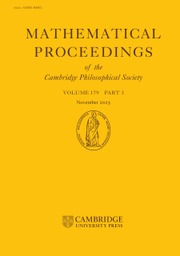No CrossRef data available.
Article contents
The connectedness of Sierpiński sponges with rotational and reflectional components and associated graph-directed systems
Published online by Cambridge University Press: 21 February 2025
Abstract
We provide two methods to characterise the connectedness of all d-dimensional generalised Sierpiński sponges whose corresponding iterated function systems (IFSs) are allowed to have rotational and reflectional components. Our approach is to reduce it to an intersection problem between the coordinates of graph-directed attractors. More precisely, let  $(K_1,\ldots,K_n)$ be a Cantor-type graph-directed attractor in
$(K_1,\ldots,K_n)$ be a Cantor-type graph-directed attractor in  ${\mathbb {R}}^d$. By creating an auxiliary graph, we provide an effective criterion for whether
${\mathbb {R}}^d$. By creating an auxiliary graph, we provide an effective criterion for whether  $K_i\cap K_j$ is empty for every pair of
$K_i\cap K_j$ is empty for every pair of  $1\leq i,j\leq n$. Moreover, the emptiness can be checked by examining only a finite number of geometric approximations of the attractor. The approach is also applicable to more general graph-directed systems.
$1\leq i,j\leq n$. Moreover, the emptiness can be checked by examining only a finite number of geometric approximations of the attractor. The approach is also applicable to more general graph-directed systems.
MSC classification
- Type
- Research Article
- Information
- Copyright
- © The Author(s), 2025. Published by Cambridge University Press on behalf of Cambridge Philosophical Society


